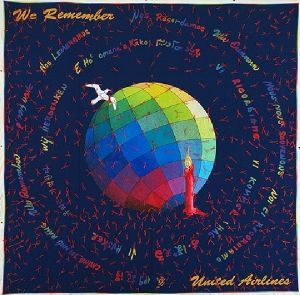 |
United Airlines We Remember
Printable
version
- Copyright © 1996 Caryl Bryer Fallert
- Size: 12' x 12'
- Materials: 100% cotton fabric / 80/20 cotton/ poly
batting
- Techniques: Hand dyed, machine pieced, appliqued, and
quilted
See more information and details below
Larger image |
 |
|
Design Concept
|
NAMES: AIDS Memorial Quilt Panel
This is the story of a 12 foot square panel made
for the Aids Memorial Quilt on behalf of the employees
of United Airlines.
See Caryl's story below.
In 1996, the United Airlines Foundation
sponsored the traveling display of a 12' x 12' quilt
panel hand-crafted by Caryl Bryer Fallert, who was,
at that time, a flight attendant for United Airlines.
The quilt was made in memory of employees, customers
and loved ones lost to this terrible disease.
This panel toured the world, making 26 stops in
18 cities in 3 countries, and was viewed and embellished
by hundred of United Airlines employees. See full
image of complete quilt.
|
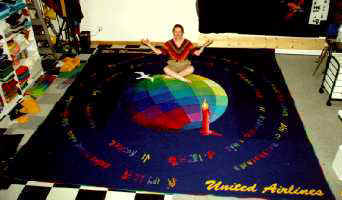
The panel is "United
Airlines We Remember" #04668 in the AIDS
quilt registery.
To go to the NAMES main site http://www.aidsquilt.org
|
Caryl's Story

We Remember |
In May of 1996 I was asked to make a panel for the
Aids Memorial Quilt on behalf of United Airlines.
It needed to be 12 feet square, and it needed to be
finished in three weeks. I spent several days designing
the 12 foot square and getting approval for the final
design.
The design has a six foot center panel with a globe
and a bird to represent the airline, and it's worldwide
employees. A red candle symbolizes remembering those
we have lost. In the upper left corner of the quilt
are the words "we remember", and in the
lower right, "United Airlines." |
In two concentric circles, surrounding the globe
are the words "we remember" written in 15
different languages.
The last week of May I constructed and quilted the
six foot square, center panel. There were still six
more three foot by six foot panels with the circles
of words, to make by the June 5 deadline. Help arrived
the first week of June. On June 3rd and 4th,
Bill Lotheridge, and Scott Nelson came to my studio
to lend a hand. |
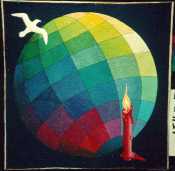 |
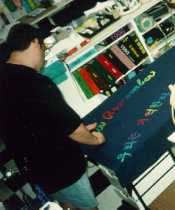 |
Working on the final six panels, then assembling
the finished quilt was an adventure for all of us.
Bill and Scott quickly learned all the parts of
quilting that don't require sewing skills, On June
3, they measured and cut all the panels, then laid
out and fused all the words to the background fabric.
The next day, Bill and Scott measured and cut the
backing panels, and batting, and pin basted the
panels together.
|
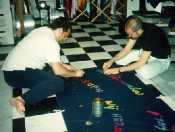
 |
|
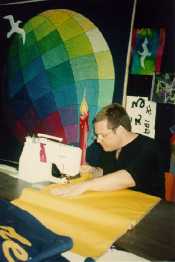
|
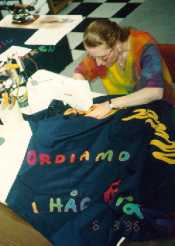
|
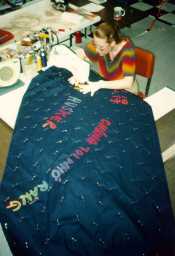
|
| Bill even did a little
sewing on the back panels. |
On June 3rd, I spent the whole day at
the sewing machine stitching the letters to the background. |
The next day, I quilted all six panels
between 6 am and 10 p.m., after which Bill and Scott
removed all the pins. |
|
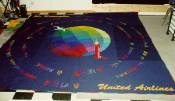 Late that night we began stitching together the
large pieces of the quilt. As the quilt grew to
12 feet square, it got heavy and awkward. Eventually
it took all three of us to haul it through the sewing
machine. At 3:30 am on the morning of June 5, the
quilt was complete.
Late that night we began stitching together the
large pieces of the quilt. As the quilt grew to
12 feet square, it got heavy and awkward. Eventually
it took all three of us to haul it through the sewing
machine. At 3:30 am on the morning of June 5, the
quilt was complete.
|
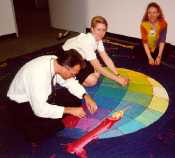 |
Later that morning, Bill began a six week journey
to take the quilt to as many United cities as possible
so that employees could attach red ribbons to remember
those they knew and loved who had died of aids.
A memory book traveled with the quilt to record
our memories of those we lost.
|
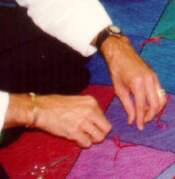
|
|
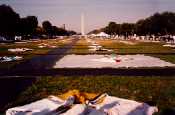 In
October of 1996, all the panels of the quilt were
displayed in Washington D.C. on the mall between
the Capitol and the Washington Monument. On Saturday,
October 12, I arrived at the Capitol Building in
Washington D.C. just in time to watch the last of
the panels being unfolded on the mall. The unfolding
ceremony requires hundreds of volunteers, dressed
in white, and lasts about an hour and a half. In
October of 1996, all the panels of the quilt were
displayed in Washington D.C. on the mall between
the Capitol and the Washington Monument. On Saturday,
October 12, I arrived at the Capitol Building in
Washington D.C. just in time to watch the last of
the panels being unfolded on the mall. The unfolding
ceremony requires hundreds of volunteers, dressed
in white, and lasts about an hour and a half.
|
|
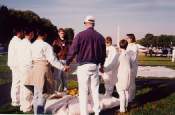
Click here
to see another picture of one of the 12 foot squares.
A detail of can be found below.
|
The quilt is made up of three by six
foot panels with the names and memories of individuals
who have died of aids. These are sewn together to
form twelve foot squares. Each of the twelve foot
squares is surrounded by a three inch white canvas
border with grommets. The twelve foot panels are
lashed together to form twenty-four foot squares.
The twenty-four foot squares are laid out on the
ground with black canvas tarpaulins about six feet
wide, |
| At sunrise, a twenty-four foot panel,
folded with it's corners to the center, is placed
diagonally in the center of each twenty-four foot
square of grass.The twenty-four foot square panels
were unfolded in rows. Each panel was unfolded by
eight volunteers. As each panel was unfolded, the
volunteers moved to their next assigned panel and
surrounded it, holding hands. |
| When all were in position from one end of the mall
to the other, a signal was given, and all the panels
in a single row were unfolded at the same time.
|
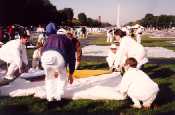
First four people reached to the center and folded
back the inside set of corners.
|
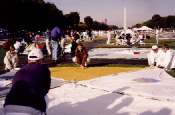
The next four people then went to the center again,
and folded back the outside set of corners.
|
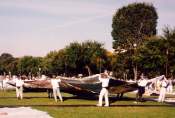 |
The unfolded twenty-four foot panel was then lifted
about the heads of the group of eight people, who
rotated it by walking clockwise, until the panel could
be placed exactly in the square between the black
canvas walkways. |
| After the quilt left my hands in June, it traveled
to twenty six different cities in the United States
and Europe. At each city, United employees were offered
to opportunity to sew a red ribbon on the quilt to
remember a fellow employee that had lost to aids.
|
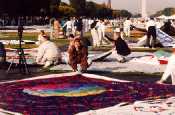 |

|
click
for larger image
| When the quilt was unfolded in
Washington, it was covered with more than a
thousand red ribbons |
|
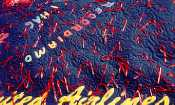
|
During the unfolding, thousands of people stood quietly
around the periphery. At the end of the unfolding,
the thousands of visitors were invited to walk among
the quilt panels. |
|
The walkways were often as crowded as the aisles
at the AQS show in Paducah, KY, but there was a
quiet kindness and respect among the visitors. The
crowd were as diverse a group as you could ever
expect to find in one place. White, African American,
Asian, Latino, rich and poor, gay and straight,
able bodied and disabled. Some individuals wept
silently by the panels of those they had loved.
It was not unusual to see a stranger approach and
lay a comforting arm on their shoulder. No one is
untouched.
From the beginning of the unfolding, until the
panels were refolded at sunset, the names of those
who have dies were read over the public address
system by a series of readers, including nationally
known political and spiritual leaders, corporate
officers, health professionals, artists, writers,
and family members of those who have died.
|
|
The squares filled the entire Washington Mall (the
space between the Capitol building and the Washington
Monument) Our panel, was in the center of the very
first row, by the Capitol reflection pool, and the
stage.
I chatted for a while with the volunteer who was
assigned the first three-hour shift in the area
of our quilt panel.....a United, customer service
representative. As we talked he said, " Someday,
my daughter will probably have a panel in this quilt.
She was a nurse" he explained, "and she
was stuck by a contaminated needle" I asked
him about the promising new drugs we have heard
about.. "Yes" he said, "She is taking
one of them now. It costs her $995.00 each month,
just for the drug. It is not covered by health insurance,
and the hospial for which she worked bears no financial
liability for the illness she contracted working
for them. She gets a disability insurance check
for $235.00 each month, and that is her only income."
Another United volunteer, one of my fellow flight
attendants, wrote the name of one of her friends
on a red ribbon and attached it to the quilt. It
was a name I knew well. At six in the morning on
Memorial Day, 1978, I was setting up the galley
on a 737, when I heard a bright, eager voice, and
I looked up to see a blond, young man in a brand
new uniform. "Hi" he said, "I'm Doug,
and this is my first flight"
|
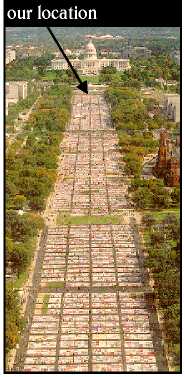 |
| There were also hundreds of panels for nurses and
doctors, priests and ministers, mothers and grandmothers,
fathers and grandfathers, and little children. |
 |
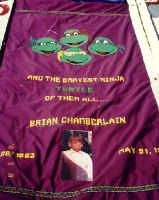 |
The panels of the well known, like Arthur Ashe,
were sewn to panels of those known only to a loving
family or a close circle of friends.
Some of the panels contained traditional patchwork
patterns. A few were even hand quilted.The vast majority
were not quilted at all. |
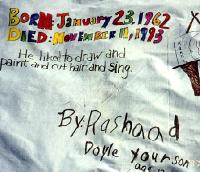 |
Many were made from clothing,
ties, and other cloth objects that belonged
to the victims. More than half included photographs
of the victims and their families. Some were
exquisitely embroidered, painted, printed, or
drawn, while others had only the crudely written
name of the victim, executed in the coarsest
of materials.
|
None lacked emotional impact.

|
|
Volunteers served three hour shifts, watching over
the quilt panels in a particular area. This was
not the kind of archival, white gloved guarding
that usually happens at quilt shows. The quilts,
after all, are laid directly on the grass. Many
relatives sat for a time or laid flowers on the
panels of their loved ones.
I walked nonstop for four hours, and realized I
wasn't even half way to the Washington Monument.
Lunch had been arranged a few blocks away, but I
decided to skip so that I could see more of the
quilt. I walked faster, and began going up only
every-other row, trying to see each twenty-four
foot panel from one side. After another hour of
walking, I had reached what I thought at the time
was the half way point.
|
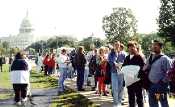 |
I began to feel light headed from no food or water,
and hoping to find a soda, headed to the edge of the
central mall where some tents were set up. Beyond
the tents were grassy tree-lined parks on both sides
of the mall. I soon discovered that these too were
filled with sections of the quilt. Stretching
for two blocks in front of one tent were people waiting
patiently in line. I wondered why so many people were
waiting in this one line. |
|
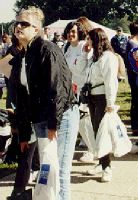
|
Then I saw a woman showing a three by six foot quilt
panel to the couple in front of her, holding it up
like any quilter at a quilt guild meeting. Suddenly,
I realized that each person in line was carrying a
plastic or cloth bag, and inside each one was a new
quilt panel, waiting to be checked in and cataloged
for inclusion in the quilt. Further along the line
were a group of five young men, each carrying a bag.
They were taking turns showing their panels and having
their pictures taken. |
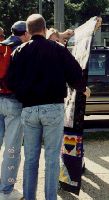
|
| I walked beside the quilt panels under the trees
for a while, then returned to the mall. Knowing I
would have to leave in the late afternoon, I walked
faster and faster, and began skipping several rows
at a time. After seven straight hours of walking,
I finally reached the Washington Monument, having
actually seen only a fraction of the entire quilt.
|
 |
As I walked along the sidewalk back to the Capitol,
I saw volunteers filling the remaining spaces under
the trees with the new panels that had been checked
in that day, and the names continued to be read aloud
for all the hear. |
They say the quilt now fills more that
twenty-four football fields, and is the largest piece
of art in history. This may have been the last time
it would be physically possible to display all of
the quilt panels in a single setting, but the leaders
of the Names Project have vowed to continue spreading
the quilt on the mall in Washington until a cure is
found, and is available to all who need it. |
|
|
|
Web Site Design by Caryl Bryer Fallert-Gentry © 1997-2022
All Rights Reserved
Bryerpatch Studio • 10 Baycliff Place • Port Townsend, WA • 98368 • USA
360-385-2568 • caryl@bryerpatch.com
•••••
|

